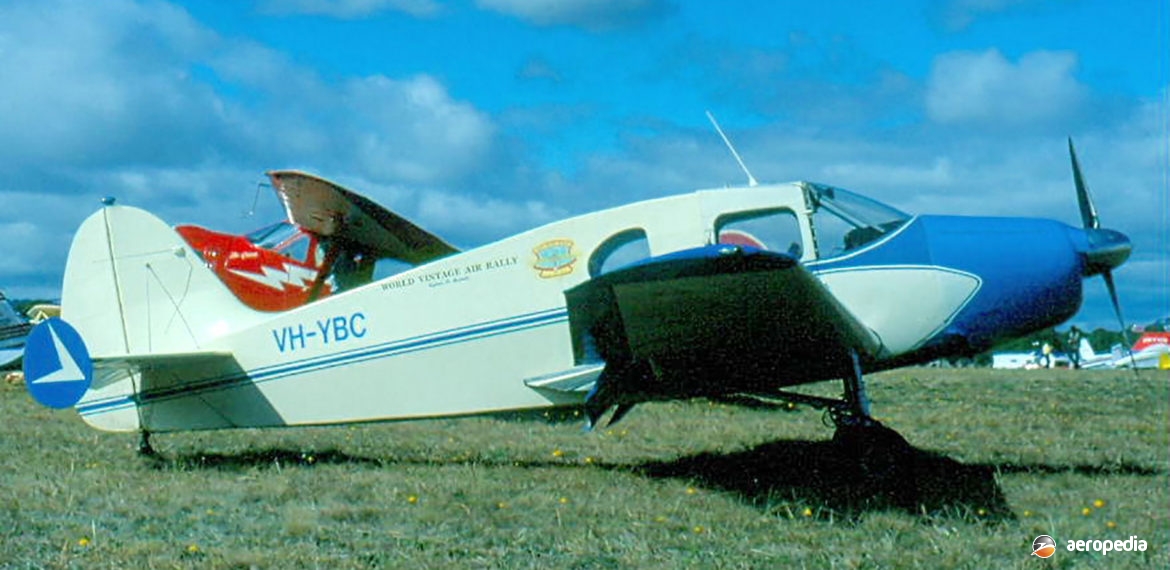Photograph:
Bellanca 14-13 Cruisair VH-YBC (c/n 1172) at Mangalore, VIC in April 1994 (David C Eyre)
Country of origin:
United States of America
Description:
Three/four-seat light cabin monoplane
Power Plant:
One 112 kw (150 hp) Franklin 6A4-335-B3 six-cylinder horizontally-opposed air-cooled engine
Specifications:
- Wingspan: 10.4 m (34 ft 2 in)
- Length: 6.52 m (21 ft 3½ in)
- Height: 1.92 m (6 ft 2½ in)
- Wing area: 15 m² (161.5 sq ft)
- Max speed: 266 km/h (165 mph)
- Cruising speed at 65 % power at 762 m (2,500 ft): 241 km/h (150 mph)
- Stalling speed no flaps: 92 km/h (57 mph)
- Landing speed: 77 km/h (48 mph)
- Initial rate of climb at sea level: 259 m/min (850 ft/min)
- Service ceiling: 4,877 m (16,000 ft)
- Cruising range at 2,375 rpm at 762 m (2,500 ft): 966 km (600 miles)
- Take-off run: 150 m (510 ft)
- Fuel capacity: 151 litres (33 Imp gals)
- Empty weight: 562 kg (1,240 lb)
- Useful load: 413 kg (910 lb)
- Loaded weight: 975 kg (2,150 lb)
History:
The Bellanca Cruisair series of light aircraft was designed by Guiseppe Bellanca and built by his company, the famous Bellanca Aircraft Corporation, of New Castle, Delaware, USA in the 1940s. It was built in large numbers in a variety of models with a variety of engines, including the 67 kw (90 hp) Rearwin, 75 kw (100 hp) Lycoming, 90 kw (120 hp) Franklin, and later, after manufacturing rights were obtained by the Downer Aircraft Company, the 171 kw (230 hp) Continental O-470-K engine. The 14-13 was developed from the 14-12, which in turn was developed from the model 14-9 of 1939, which had the 67 kw (90 hp) Ken Royce 5-F or 5-G five-cylinder radial engine.
The Model 14-13 was certified in September 1946 and became renowned for its strength and performance. New models appeared in the following years, including the 14-13-2 in 1947 having a gross weight of 975 kg (2,150 lb), the 14-13-3 having the power increased to 118 kw (158 hp), and the 14-13-3W in 1948, being known as the Estate Wagon. The baggage compartment had an allowance for 50 kg (110 lb) or 0.16 m³ (5.7 cub ft).
The Model 14-13 prototype NX41878 (c/n 1060) was first shown at the National Aircraft Show held in Cleveland in Ohio in the US in 1946 and at that time Bellanca announced it had orders for 1,300 aircraft. However, it seems these orders were not firm and the Company built many aircraft but had to be parked at the manufacturer’s facility for some time until sold. Production output was then reduced for a period until orders increased.
The wing was built of wood spruce spar beams with spruce and plywood truss-type wing ribs, the completed wing being covered with mahogany plywood sheet and a layer of fabric. The fuselage was built up of welded chrome-moly steel tubing, faired to shape with spruce fairing strips and fabric covered. Fuel was contained in a 76 litres (16.6 Imp gals) tank in each wing. Toe-operated hydraulic brakes were fitted, the wing-flaps were manually operated and the undercarriage was retracted manually by a system of chains and sprockets via a floor-mounted crank handle requiring 32 to 38 turns. Provision was made for an electrically-operated undercarriage retracting system as an option on late-built models.
The first of the type seen in Australia arrived in 1990 as an entrant in the World Vintage Aircraft Rally from the United Kingdom to Australia. This aircraft subsequently remained in Australia and became VH-YBC (c/n 1172) in June 1992, initially based in the Hoppers Crossing area, and later at Riddell Creek, VIC. This aircraft was fitted with a Franklin 6A4-150-B-3 engine.

